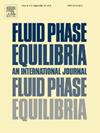使用 2-戊酮、环己酮和 4-甲基-2-戊酮从甘油中萃取碳酸甘油酯的液液平衡数据的测定和相关性研究
IF 2.8
3区 工程技术
Q3 CHEMISTRY, PHYSICAL
引用次数: 0
摘要
碳酸甘油酯是甘油的一种高价值衍生物,在化妆品、药品和食品工业以及增塑剂和电池电解液中都有广泛的应用。本研究评估了使用三种溶剂从甘油中提取碳酸甘油酯的可行性:2-戊酮、环己酮和 4-甲基-2-戊酮。虽然 4-甲基-2-戊酮表现出较高的萃取选择性,但碳酸甘油酯在其中的分配系数小于 1。相反,虽然环己酮的分配系数较高,但其萃取选择性较低。相比之下,2-戊酮的萃取选择性和萃取能力相对平衡。在平衡数据关联中,使用了非随机双液(NRTL)模型作为活性模型,并估算了相应的二元相互作用参数。NRTL 模型的回归参数成功地再现了所有研究体系的相平衡趋势,有助于从甘油中萃取碳酸甘油酯的工艺设计和溶剂筛选。本文章由计算机程序翻译,如有差异,请以英文原文为准。
Determination and correlation of liquid-liquid equilibrium data for the extraction of glycerol carbonate from glycerol using 2-pentanone, cyclohexanone, and 4-methyl-2-pentanone
Glycerol carbonate, a high-value derivative of glycerol, finds extensive applications in the cosmetics, pharmaceuticals, and food industries, as well as in plasticizers and battery electrolytes. This study assessed the feasibility of extracting glycerol carbonate from glycerol using three solvents: 2-pentanone, cyclohexanone, and 4-methyl-2-pentanone. The extraction performance of these solvents was evaluated through liquid-liquid equilibrium (LLE) measurements at atmospheric pressure and temperatures of 303.2 K, 313.2 K, and 323.2 K. Although 4-methyl-2-pentanone exhibited high extraction selectivity, the distribution coefficient of glycerol carbonate in it was less than one. Conversely, while cyclohexanone provided a high distribution coefficient, its extraction selectivity was low. In contrast, 2-pentanone demonstrated a relatively balanced extraction selectivity and capacity. The Non-Random Two-Liquid (NRTL) model was used as an activity model in the equilibrium data correlation, and the corresponding binary interaction parameters were estimated. The regressed parameters of the NRTL model successfully reproduced the phase equilibrium trends observed for all systems investigated, facilitating process design and solvent screening for glycerol carbonate extraction from glycerol.
求助全文
通过发布文献求助,成功后即可免费获取论文全文。
去求助
来源期刊

Fluid Phase Equilibria
工程技术-工程:化工
CiteScore
5.30
自引率
15.40%
发文量
223
审稿时长
53 days
期刊介绍:
Fluid Phase Equilibria publishes high-quality papers dealing with experimental, theoretical, and applied research related to equilibrium and transport properties of fluids, solids, and interfaces. Subjects of interest include physical/phase and chemical equilibria; equilibrium and nonequilibrium thermophysical properties; fundamental thermodynamic relations; and stability. The systems central to the journal include pure substances and mixtures of organic and inorganic materials, including polymers, biochemicals, and surfactants with sufficient characterization of composition and purity for the results to be reproduced. Alloys are of interest only when thermodynamic studies are included, purely material studies will not be considered. In all cases, authors are expected to provide physical or chemical interpretations of the results.
Experimental research can include measurements under all conditions of temperature, pressure, and composition, including critical and supercritical. Measurements are to be associated with systems and conditions of fundamental or applied interest, and may not be only a collection of routine data, such as physical property or solubility measurements at limited pressures and temperatures close to ambient, or surfactant studies focussed strictly on micellisation or micelle structure. Papers reporting common data must be accompanied by new physical insights and/or contemporary or new theory or techniques.
 求助内容:
求助内容: 应助结果提醒方式:
应助结果提醒方式:


